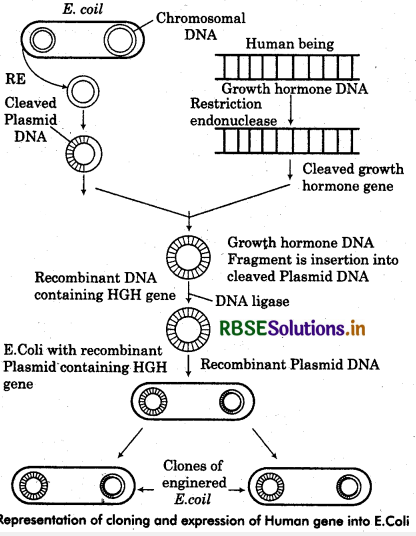RBSE Solutions for Class 12 Biology Chapter 12 Biotechnology and its Applications
Rajasthan Board RBSE Solutions for Class 12 Biology Chapter 12 Biotechnology and its Applications Textbook Exercise Questions and Answers.
RBSE Class 12 Biology Solutions Chapter 12 Biotechnology and its Applications
RBSE Class 12 Biology Biotechnology and its Applications Textbook Questions and Answers
Question 1.
Crystals of BT toxin produced by some bacteria do not kill the bacteria themselves because:
(a) bacteria are resistant to the toxin.
(b) toxin is immature.
(c) toxin is inactive.
(d) bacteria encloses toxin in a special sac.
Answer:
(b) Toxin is immature.

Question 2.
What are transgenic bacteria? Illustrate using one example.
Answer:
Transgenic bacteria are those. In which external genes are inserted into their DNA. These foreign gene contain desire characters which use for human welfare, like production of food, medicines, biochemical etc. The most commonly used transgenic bacteria is E.coli which is highly efficient to produce desired protein e.g., insulin.
E.coli in insulin Production: E.coli bacteria through rDNA technology used to grow in culture medium with amino acid that make up insulin. Both the chain A and B are synthesised separately and later bonded together to form insulin.
Question 3.
Compare and contrast the advantages and disadvantage of production of genetically modified crops.
Answer:
|
Benefit |
Lesses |
|
1. Genetically modified plants have less dependence on chemical pests. |
1. Genetically modified crops can cause allergies in people. |
|
2. Genetically modified plants virus resistance and immunity against harmful pests. |
2. Genetically modified crops are very expensive. |
|
3. Genetically modified plant are capable of with standing adverse conditions such as drought, extreme cold. |
3. In process of cutting such crops, many plant residues are left in the ground, which damages the biological atmosphere. |
|
4. Genetically modified plants developed for conversion to produce commercially high quantities on parameters. |
4. Ability to producing seeds is reduced in such crops. |
|
5. Genetically modified plants replenishment of soil. |
5. Undesirable harmful variety can be produce. |
Question 4.
What are cry proteins? Name an organism that produce it. How has man exploited this protein to his benefits?
Answer:
Cry proteins are produce by a cry gene family which is found in Bacillus thuringiensis bacteria. These are toxic genes produce protein crystals encoded by gene CrylAC and CryllAb. Different Bacillus thuringiensis produce different strains of toxin. Which are harmful for different insects like butterflies, bollworm, moths etc. Man exploited gene by isolated this from bacteria and introduced in cotton plant. Which makes the plant resistant to insects variety called Bt cotton. In India mostly Bollworm resistant Bt cotton plants are cultivated.
Question 5.
What is gene therapy? Illustrate using the example of adenosine deaminase (ADA) deficiency.
Answer:
Gene therapy is a medical field which focuses on the utilisation of the therapetic delivery of nucleic acid (gene) into patient’s cell as a drug to treat disease. Very first experiment of gene therapy performed on 4 year old girl with ADA deficiency. This enzyme is very crucial for immune system. Permanent gene therapy can be done by replacement of ADA gene from bone marrow cells of early embryonic stages. It is parmanent and fully successed.
Question 6.
Digranunatically represent the experimental steps in cloning and expression an human gene (say the gene for growth hormone) into a bacterium like E.coli?
Answer:

Question 7.
Can you suggest a method to remove oil (hydrocarbon) from seeds based on your under - standing of rDNA technology and chemistry of oil?
Answer:
rDNA technology is used to manipulated genes to get desire result, if we delet the oil - making genes from seed with the help of endonuclease enzymes, we will get seeds without oil. Oil is formed by the organisation of three fatty acids with one molecule of glycrol. Fatty acids are formed by an enzyme called fatty acid synthesis, inactivation of fatty acids producing one or more genes may inhibits the synthesis of fatty acids.
Question 8.
Find out from internet what is golden rice?
Answer:
Golden rice is a transgenic plant of rice, enrich in vitamin A called beta carotene. Golden rice was developed by Swiss Federal Institute of 'Technology. Colour of golden rice is yellow due to beta caratene. GM golden rice has been modified by inserting a gene from maize and a gene from bacteria which allow the plant to biosynthesis of beta - carotene in edible parts of rice.

Question 9.
Does our blood have proteases and nucleases?
Answer:
No, it does not have, but the cells of blood digested some protease exists in inactive form.
Question 10.
Consult internet and find out how to make orally active protein pharmaceutical. What is the major problem to be encountered?
Answer:
Orally active protein are specific biologically active material like protein or peptide and antibodies included in the orally active protein pharmaceutical. The peptide or proteins present in them are useful for the treatment of difficult disease e.g., Polio, Hepatities B etc., gene that produce protein or peptide isolated from specific bacteria and grown in culture medium for commercial porpose but the problem is when they taken through mouth stomach juices denature the protein and make them uneffective. The problem can be encountered as follow:
- By putting the proteins in coated tablets so that stomach juice can not denature them and proteins get absorbed in intestine.
- The way around this is to protect the protein with a covering that will dissolved after it has passed through the stomach.
